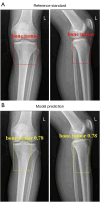Deep learning-based detection of primary bone tumors around the knee joint on radiographs: a multicenter study
- PMID: 39144039
- PMCID: PMC11320541
- DOI: 10.21037/qims-23-1743
Deep learning-based detection of primary bone tumors around the knee joint on radiographs: a multicenter study
Abstract
Background: Most primary bone tumors are often found in the bone around the knee joint. However, the detection of primary bone tumors on radiographs can be challenging for the inexperienced or junior radiologist. This study aimed to develop a deep learning (DL) model for the detection of primary bone tumors around the knee joint on radiographs.
Methods: From four tertiary referral centers, we recruited 687 patients diagnosed with bone tumors (including osteosarcoma, chondrosarcoma, giant cell tumor of bone, bone cyst, enchondroma, fibrous dysplasia, etc.; 417 males, 270 females; mean age 22.8±13.2 years) by postoperative pathology or clinical imaging/follow-up, and 1,988 participants with normal bone radiographs (1,152 males, 836 females; mean age 27.9±12.2 years). The dataset was split into a training set for model development, an internal independent and an external test set for model validation. The trained model located bone tumor lesions and then detected tumor patients. Receiver operating characteristic curves and Cohen's kappa coefficient were used for evaluating detection performance. We compared the model's detection performance with that of two junior radiologists in the internal test set using permutation tests.
Results: The DL model correctly localized 94.5% and 92.9% bone tumors on radiographs in the internal and external test set, respectively. An accuracy of 0.964/0.920, and an area under the receiver operating characteristic curve (AUC) of 0.981/0.990 in DL detection of bone tumor patients were for the internal and external test set, respectively. Cohen's kappa coefficient of the model in the internal test set was significantly higher than that of the two junior radiologists with 4 and 3 years of experience in musculoskeletal radiology (Model vs. Reader A, 0.927 vs. 0.777, P<0.001; Model vs. Reader B, 0.927 vs. 0.841, P=0.033).
Conclusions: The DL model achieved good performance in detecting primary bone tumors around the knee joint. This model had better performance than those of junior radiologists, indicating the potential for the detection of bone tumors on radiographs.
Keywords: Bone neoplasms; deep learning (DL); knee joint; radiography.
2024 Quantitative Imaging in Medicine and Surgery. All rights reserved.
Conflict of interest statement
Conflicts of Interest: All authors have completed the ICMJE uniform disclosure form (available at https://qims.amegroups.com/article/view/10.21037/qims-23-1743/coif). All authors report the funding from the Natural Science Foundation of Guangdong Province, China (No. 2022A1515011593) and the Medical Research Foundation of Guangdong Province, China (No. A2021010). The authors have no other conflicts of interest to declare.
Figures








Similar articles
-
Deep learning for differentiation of osteolytic osteosarcoma and giant cell tumor around the knee joint on radiographs: a multicenter study.Insights Imaging. 2024 Feb 7;15(1):35. doi: 10.1186/s13244-024-01610-1. Insights Imaging. 2024. PMID: 38321327 Free PMC article.
-
Primary bone tumor detection and classification in full-field bone radiographs via YOLO deep learning model.Eur Radiol. 2023 Jun;33(6):4237-4248. doi: 10.1007/s00330-022-09289-y. Epub 2022 Nov 30. Eur Radiol. 2023. PMID: 36449060
-
A radiograph-based deep learning model improves radiologists' performance for classification of histological types of primary bone tumors: A multicenter study.Eur J Radiol. 2024 Jul;176:111496. doi: 10.1016/j.ejrad.2024.111496. Epub 2024 May 7. Eur J Radiol. 2024. PMID: 38733705
-
Deep learning-based classification of primary bone tumors on radiographs: A preliminary study.EBioMedicine. 2020 Dec;62:103121. doi: 10.1016/j.ebiom.2020.103121. Epub 2020 Nov 22. EBioMedicine. 2020. PMID: 33232868 Free PMC article.
-
Multitask Deep Learning for Segmentation and Classification of Primary Bone Tumors on Radiographs.Radiology. 2021 Nov;301(2):398-406. doi: 10.1148/radiol.2021204531. Epub 2021 Sep 7. Radiology. 2021. PMID: 34491126
References
LinkOut - more resources
Full Text Sources
